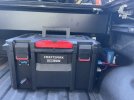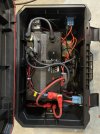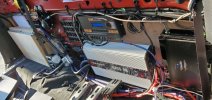I've added a battery box to the bed of my truck. This is to run a fridge, some lights, and a few other DC devices when camping.
Prior to this, I installed (and still have) light pods on my A-pillars. I want to be able to run these from the battery box so I can use them when stopped if I need some extra light, without worrying about draining the starting battery.
But sometimes, I don't want to lug that battery boxy around, so I came up with what I thought was an ingenious idea: Using Anderson SB50 connectors, I can plug a junction box into either the truck or the battery box. This worked well when I had both a positive and negative wire running from the junction box back to the engine bay, where the A-pillar light pods are connected. (The reason for running from the junction box back to the engine bay is because I want the option to run the pods from the battery box).
Then it occurred to me, there's no reason to run two lengths of wire (positive and negative), when I can simply ground the pods to the chassis; there are ground points on both sides of the engine bay, so this is easy to do.
That works fine when I've got the Anderson plug from the junction box plugged into the Anderson plug to the truck (run via 6 AWG wire). I was confused for longer than I should have when it no longer worked when connected to my battery box, until I said, duh, of course, I no longer have a circuit, because the light is grounded to the chassis, but the battery box is not.
So, just ground the battery box to the chassis too, right? Grounding a "house" battery appears to be common for RVs and trailers.
But, would doing so confuse the truck's IBS? Would the truck assume the power being consumed from my battery box (fridge, lights, etc.) is actually being drawn from the truck's battery? Likewise, my battery box is charged via solar; would the truck's IBS think it's receiving charge that it's not?
Likewise, I've got something akin to an IBS on the battery box (Victron SmartShunt). Like the IBS, it connects to the negative terminal on the battery, then the load's negative connects to the SmartShunt rather than the negative battery terminal. Would my SmartShunt think that power discharged from and charged to the starter battery is coming from my battery box?
Would both the truck and SmartShunt get a wrong picture of state of charge?
Photos coming...
Prior to this, I installed (and still have) light pods on my A-pillars. I want to be able to run these from the battery box so I can use them when stopped if I need some extra light, without worrying about draining the starting battery.
But sometimes, I don't want to lug that battery boxy around, so I came up with what I thought was an ingenious idea: Using Anderson SB50 connectors, I can plug a junction box into either the truck or the battery box. This worked well when I had both a positive and negative wire running from the junction box back to the engine bay, where the A-pillar light pods are connected. (The reason for running from the junction box back to the engine bay is because I want the option to run the pods from the battery box).
Then it occurred to me, there's no reason to run two lengths of wire (positive and negative), when I can simply ground the pods to the chassis; there are ground points on both sides of the engine bay, so this is easy to do.
That works fine when I've got the Anderson plug from the junction box plugged into the Anderson plug to the truck (run via 6 AWG wire). I was confused for longer than I should have when it no longer worked when connected to my battery box, until I said, duh, of course, I no longer have a circuit, because the light is grounded to the chassis, but the battery box is not.
So, just ground the battery box to the chassis too, right? Grounding a "house" battery appears to be common for RVs and trailers.
But, would doing so confuse the truck's IBS? Would the truck assume the power being consumed from my battery box (fridge, lights, etc.) is actually being drawn from the truck's battery? Likewise, my battery box is charged via solar; would the truck's IBS think it's receiving charge that it's not?
Likewise, I've got something akin to an IBS on the battery box (Victron SmartShunt). Like the IBS, it connects to the negative terminal on the battery, then the load's negative connects to the SmartShunt rather than the negative battery terminal. Would my SmartShunt think that power discharged from and charged to the starter battery is coming from my battery box?
Would both the truck and SmartShunt get a wrong picture of state of charge?
Photos coming...















